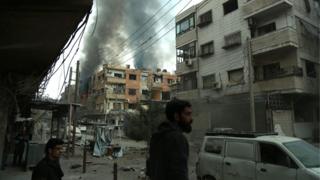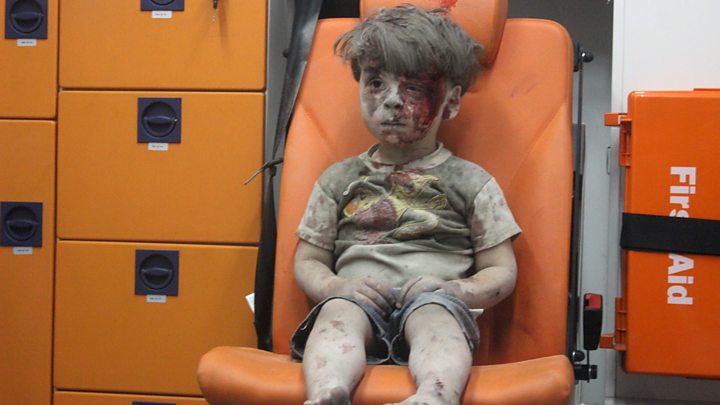 Image copyright
Image copyright
AFP/Getty
The Syrian army says it has completely surrounded the town of Douma, which has been under heavy bombardment
US Defence Secretary Jim Mattis has warned Syria it would be “very unwise” to use poison gas in Eastern Ghouta amid reports of chlorine attacks.
Mr Mattis did not say President Trump would take military action, but the US struck Syria last April after a suspected gas attack in northern Syria.
Fierce fighting is continuing and the Syrian army says it has surrounded a major town in the rebel-held enclave.
More than 1,000 civilians have been reported killed in recent weeks.
The Syrian military has been accused of targeting civilians, but it says it is trying to liberate the region – the last major opposition stronghold near the capital Damscus – from those it terms terrorists.
- Eastern Ghouta devastation seen from space
- Why is there a war in Syria?
- Read more: Who’s fighting whom in Syria’s Ghouta?
What did Mr Mattis say?
Mr Mattis said Mr Trump had “full political manoeuvre room” to respond to chlorine use.
Rescue workers and activists in Eastern Ghouta say the Syrian government has used chlorine during its assault, but the government denies this.
Mr Mattis did not say he had conclusive evidence gas had been used, but added: “It would be very unwise for them to use weaponised gas. And I think President Trump made that very clear early in his administration.
He was referring to the US cruise missile strike on a Syrian government air base after more than 80 people were killed in a sarin gas attack in the town of Khan Sheikhoun. Last October a UN report said the Syrian government had been behind the attack.
Mr Mattis also criticised Russia, a key ally of Syrian President Bashar al-Assad, which had agreed to oversee the destruction of Syrian chemical weapon stockpiles under a 2013 deal.
“Either Russia is incompetent or in cahoots with Assad. There’s an awful lot of reports about chlorine gas use or about symptoms that could be resulting from chlorine gas,” he said.
What’s happening on the ground?
The Syrian army says it has completely surrounded the town of Douma and cut the remaining rebel-held area into two, according to a statement made by the Lebanese Hezbollah militia, which is fighting on the side of the Syrian government.
But a spokesman for one of the main rebel groups earlier told Reuters that neither Douma nor the western town of Harasta had been cut off. That followed reports that the Syrian army had captured the central town of Misraba, which is on a road linking Douma and Harasta.
The BBC’s Arab Affairs editor Sebastian Usher says the army’s strategy is to divide the enclave into isolated sections and so cut off rebel support and supply networks.
Some of the fiercest fighting has been on the eastern edge of the area still under rebel control – the stronghold of one of the two main rebel groups, Faylaq al-Rahman, which is part of the Free Syrian Army.
Some reports say local leaders have been negotiating an evacuation deal for one of the towns, but Faylaq al-Rahman has denied this, vowing to fight on.
What is the situation for civilians?
Civilians have been sheltering in basements amid continuing government strikes.
The International Committee of the Red Cross (ICRC) told the BBC that some residents were going weeks without seeing sunlight because they were too frightened to go out.
“They go out only whenever they want to bring some food for their children,” said ICRC spokeswoman Ingy Sedky.
“And this is when they basically lose their life because it’s becoming very, very dangerous to stay outside basements.”
Image copyright
AFP/Getty
Continuing air strikes are forcing residents to stay in basements
On Friday a UN convoy was able to successfully deliver aid to Eastern Ghouta, after previous deliveries were halted by shelling.
Some 400,000 people are still thought to live in the area, seven years into Syria’s civil war. It has been besieged by government forces since 2013.
Who are the rebels?
The rebels in Eastern Ghouta are not one cohesive group. They encompass multiple factions, including jihadists, and in-fighting between them has led to past losses of ground to the Syrian government.
The two largest groups are Jaish al-Islam and its rival Faylaq al-Rahman. The latter has in the past fought alongside HTS.

Eastern Ghouta is so close to Damascus that it is possible for rebels to fire mortars into the heart of the capital, which has led to scores of civilian deaths.
The Syrian government is desperate to regain the territory, and has said its attempts to recapture it can be attributed directly due to the HTS presence there. HTS was excluded from a ceasefire agreed at the UN that has yet to come into effect.
The group is an alliance of factions led by the Nusra Front, which sprang from al-Qaeda.
Eastern Ghouta: Mattis warns Syria over ‘weaponised gas’

